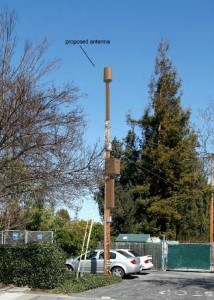
AT&T’s proposed DAS antenna
AT&T’s ambitious plans to fill in cellular coverage gaps with smaller cellular antennas won approval in Palo Alto, Calif. last week, despite protests from residents who live adjacent to one of the 75 future antenna sites.
AT&T’s new Distributed Antenna System (DAS) is designed to cover reception gaps and cope with congestion-related issues in urban and residential areas. The new antennas will be mounted on top of existing utility poles, extending their height approximately nine feet.
AT&T said the new DAS system was necessary in Palo Alto because of the city’s unique topography and building density. The company hopes the lower profile antennas, designed for neighborhood-wide coverage, will also reduce traffic on its existing cellular network. AT&T expects to install one DAS antenna every 1/4 to 1/3 of a mile.
The new antennas will be serviced from a cabinet mounted on the pole or sidewalk-based concrete pad. This cabinet houses a fiber connection from AT&T’s U-verse network as well as power and monitoring systems necessary to operate the antenna.
AT&T earlier announced it intended to deploy smaller, more-localized cell sites to bolster coverage and network capacity. Many of these antennas will be located in residential and suburban areas that have traditionally rejected large cell towers.
Although the antennas are designed to be fitted to pre-existing utility poles, some residents object to their additional height, which can bring them into view above nearby buildings and trees.
Dorianne and Roy Moss will have one of the antennas as a new neighbor, and they don’t like it.
“When I open my eyes in the morning I see a tree line,” Dorianne Moss said. “The current proposal would be to put a box 9 feet above that.”
 Local residents want AT&T to consider shielding certain antennas from public view and AT&T insists it took residents’ complaints into account.
Local residents want AT&T to consider shielding certain antennas from public view and AT&T insists it took residents’ complaints into account.
Paul Albritton, AT&T’s counsel, told Palo Alto city officials the company chose locations away from block corners and close to foliage.
Residents in other cities may find AT&T seeking to install similar antennas in the coming year.


 Subscribe
Subscribe North Carolina has achieved a new low. It is now tied with bottom-rated Mississippi as America’s least-connected state, at least in terms of broadband adoption.
North Carolina has achieved a new low. It is now tied with bottom-rated Mississippi as America’s least-connected state, at least in terms of broadband adoption.
 AT&T has announced its intention to acquire the last remaining pieces of Alltel that were left behind after Verizon Wireless acquired most of the company in 2008.
AT&T has announced its intention to acquire the last remaining pieces of Alltel that were left behind after Verizon Wireless acquired most of the company in 2008. AT&T’s WiMAX Internet service in Alaska
AT&T’s WiMAX Internet service in Alaska 